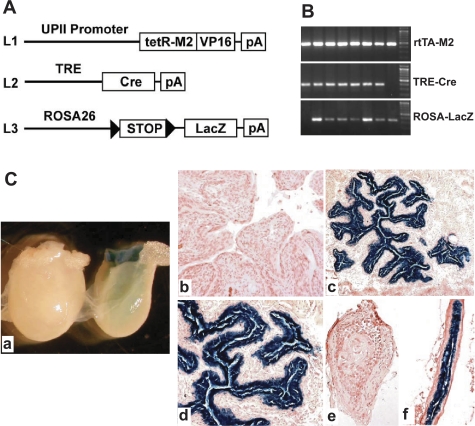Fig. 6.
Generation and characterization of a urothelium-specific and inducible knockout system. A: schematic drawing showing the knockout strategy consisting of 3 different lines. Line 1 (L1) harboring the UPII-driven rtTA-M2; line 2 (L2) harboring a Cre recombinase gene under the control of TRE; line 3 (L3) harboring a ROSA26 promoter driving a bacterial LacZ reporter gene whose expression depends on the excision of a loxP-flanked STOP sequence on Cre expression (arrowheads denote loxP sites). B: PCR genotyping of the offspring derived from multiple intercrosses among the 3 mouse lines in A. Primers specific for rtTA-M2, TRE-Cre, and ROSA-LacZ transgene alleles amplified a 500-, a 380-, and a 350-bp PCR product, respectively, in triple transgenic mice (all lanes except the first and last lane that represented double transgenic mice). C: induction of bacterial LacZ reporter gene expression in UPII-rtTA-M2/TRE-Cre/ROSA26-LacZ triple transgenic mice. The bladders (a-d) and ureters (e and f) of the triple transgenic mice receiving no Dox treatment (a, left, and b) or treated with Dox for 10 days were histochemically stained for bacterial β-galactosidase activity (see materials and methods for details) and photographed either with a dissecting microscope (a) or a conventional transmission light microscope (b-e). Note the complete absence of urothelial staining in untreated triple transgenic mice (a, left, b, and e) and the extremely strong staining of β-galactosidase activity in Dox-treated triple transgenic mice (a, right, c, d, and f).

